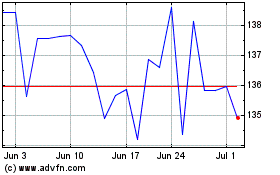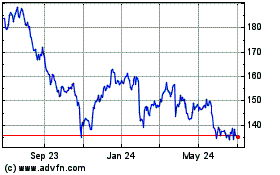Today's Top Supply Chain and Logistics News From WSJ
August 04 2017 - 7:06AM
Dow Jones News
By Paul Page
Sign up: With one click, get this newsletter delivered to your
inbox.
Pricing competition is already breaking out in the parcel world
well before this year's holiday shipping season. FedEx Corp. came
out with its new surcharges for the peak delivery period, and the
carrier is taking a sharply different path than rival United Parcel
Service Inc. FedEx is raising charges, but the WSJ's Paul Ziobro
reports the operator is focusing its increases on the weight and
size of shipments, adding hefty penalties for oversize boxes and
odd-shaped goods that fall outside the company's handling
guidelines. UPS, by contrast, is basing new surcharges on the
timing of shipments, making it more expensive to deliver to homes
around the peak periods. Both companies are trying to manage the
surge of e-commerce shipments that strains operations and profit
margins, and UPS with its surcharge strategy aims to convince
retailers to spread out shipments. FedEx is gambling it can cover
the extra costs of a demand spike while ensuring that bigger
shipments pay a hefty price for slowing down operations.
A new generation of robots is heading into warehouses with a new
message for workers: we want to collaborate, not compete. Several
automation companies are designing robots meant to work alongside
people rather than to completely replace manpower, WSJ Logistics
Report's Jennifer Smith writes, a sign that strategies for using
robotics in warehouse operations are evolving as the technology
develops and companies get more experience in using it on a daily
basis. The new robots being deployed by companies including
Deutsche Post AG's DHL, Quiet Logistics Inc. and RK Logistics Group
are small and relatively cheap mobile machines that move alongside
humans and help them work more efficiently. Robotics firms pitch
them as a way to boost productivity during busy times, such as the
holidays, when extra labor is harder to find. That's not as
ambitious as automating an entire warehouse, of course, but
developers say the lower cost makes them easier to insert into
existing operations -- and find the common ground between robots
and humans.
Alibaba Group Holding Ltd.'s new pact with luxury conglomerate
Kering Co. comes laden with significance beyond any goods it may
bring to online marketplaces. Kering, whose brands include Gucci
and Saint Laurent, is dropping its lawsuit against Alibaba over the
sale of counterfeit goods on Alibaba's websites, the WSJ's Matthew
Dalton and Liza Lin report, adding to an ongoing rapprochement
between the luxury industry and China's e-commerce companies. Key
high-end retailers are cautiously agreeing to sell through China's
online platforms, pushing aside concerns about China's unruly
counterfeiting industry using these websites to peddle fakes. Just
this week, Saint Laurent said it would sell over the internet in
China for the first time through a partnership involving JD.com,
China's second-largest online retailer. Under its deal with
Alibaba, Kering will take part in a "joint task force" aimed at
pursuing counterfeiters, at step toward what Kering's brands hope
will be the pursuit of more sales in China.
SUPPLY CHAIN STRATEGIES
Retailer Uniqlo is trying to put its clothing in front of
customers in the real world without investing in more
brick-and-mortar stores. The apparel seller owned by Fast Retailing
Co. is rolling out vending machines at several airports and
shopping malls that will dispense Uniqlo's apparel to people who
may need a quick addition to their outfits, the WSJ's Khadeeja
Safdar reports. It's part of a retooled expansion after the company
stumbled in its early efforts to move into the U.S., and the latest
sign of imaginative strategies retailers are undertaking to find
consumers without investing in big storefronts. Many retailers are
looking for a middle-ground between physical stores and moving
entirely online, and some like Best Buy Co. have already turned to
vending for some staples. Clothing marks a new frontier, and Uniqlo
will cope with added complications in its distribution channels,
including delivering goods to the sites, tracking the inventory and
dealing with those returns.
QUOTABLE
IN OTHER NEWS
Toyota Motor Corp and rival Mazda Motor Corp. plan to build a
$1.6 billion factory in the U.S. by 2021 that would create 4,000
jobs.(WSJ)
Orders for heavy-duty trucks in the U.S. rose 5% from June to
July. (WSJ)
Inflation in the Group of 20 largest economies fell in June to
its lowest level in almost eight years. (WSJ)
China is urging the Trump administration to back off plans for
tough trade actions, warning that conflict would hurt both sides.
(WSJ)
Drug giant Teva Pharmaceuticals Industries Ltd. slashed its
outlook amid growing competition, leadership woes and difficulties
in a sprawling supply chain built through acquisitions. (WSJ)
Tesla Inc. may issue new debt this year as efforts to ramp up
production of its Model 3 sedan drain cash reserves. (WSJ)
Amazon.com Inc. says its new 260,000-square-foot distribution
center outside Melbourne is "just the start" of its expansion in
Australia. (The Australian)
An Australian court fined Nippon Yusen Kabushiki Kaisha, or NYK
Line, nearly $20 million for colluding with other carriers to fix
prices for shipping cars. (Sydney Morning Herald)
Mercedes-Benz Trucks will start using 3D printing to produce
spare and replacement truck parts. (Fleet Owner)
Uber Technologies Inc. expanded the geographic reach of its Uber
Freight truck load-matching app. (Heavy Duty Trucking)
DHL Supply Chain is expanding its use of "smart glasses" for
warehouse workers in its world-wide operations after completing a
test of the devices. (Supply Chain Digital)
Teekay Tankers Ltd. swung to a $7.1 million net loss on a steep
decline in revenue in what it called an oversupplied global tanker
market. (Lloyd's List)
U.S. ethanol inventories are near an all-time high. (Omaha
World-Herald)
Australia's IFM Investors bought a 40% stake in Turkey's Mersin
International Port from Akfen Holding. (Daily Sabah)
ABOUT US
Paul Page is deputy editor of WSJ Logistics Report. Follow him
at @PaulPage, and follow the entire WSJ Logistics Report team:
@brianjbaskin , @jensmithWSJ and @EEPhillips_WSJ. Follow the WSJ
Logistics Report on Twitter at @WSJLogistics.
Write to Paul Page at paul.page@wsj.com
(END) Dow Jones Newswires
August 04, 2017 06:51 ET (10:51 GMT)
Copyright (c) 2017 Dow Jones & Company, Inc.
United Parcel Service (NYSE:UPS)
Historical Stock Chart
From Mar 2024 to Apr 2024

United Parcel Service (NYSE:UPS)
Historical Stock Chart
From Apr 2023 to Apr 2024
